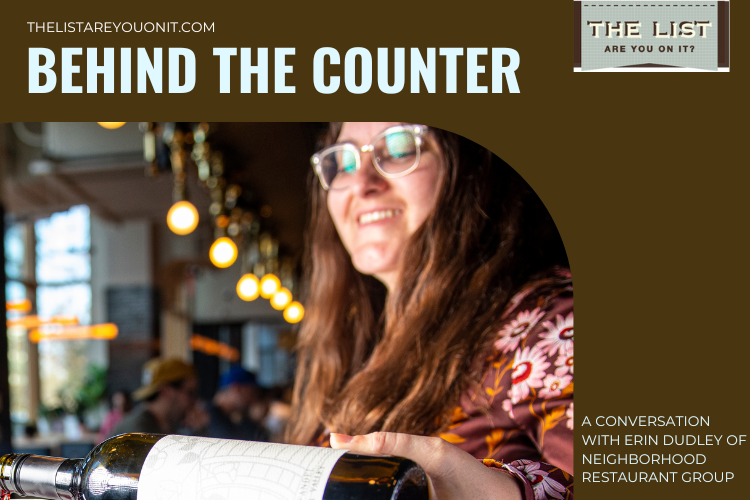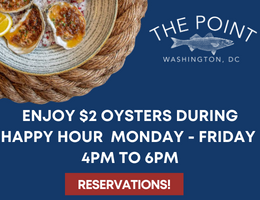
Behind the Counter with Neighborhood Restaurant Group’s Erin Dudley
TheListAreYouOnIt has been a big fan Erin Dudley since she was promoted to Wine Director of Neighborhood Restaurant in 2021. Erin is a wine expert with a diverse background and a deep passion for sustainable winemaking. Originally from Tampa, FL, Erin started her career in wine as a sales and marketing associate at DCanter, a local wine shop and quickly advanced to become a Wine Concierge, curating personalized wine selections and teaching classes on wine regions. She also pursued multiple sommelier certifications during this time. In October 2019, Erin joined Neighborhood Restaurant Group worked through many of their properties and now she oversees and manages the wine lists at each of its restaurants, bars, and e-commerce platform. Her focus is on converting all the properties’ wine lists to 100% sustainable or responsible producers. Erin is a certified sommelier and currently a Wine & Spirits Education Trust Diploma Candidate, completing a globally recognized certification in wine education.
Recently, Erin curated the wine program at Neighborhood Restaurant Group’s latest concept, Josephine. The program is anchored by a collection of more than 350 French wines. As lovers of French wines and especially Champagne varietals we asked Erin to chat with us about her love of French wines and how she was inspired to create diverse range of offerings that include both traditional and modern winemaking styles. Prepare to swirl and sniff … Read on …
When I was very young, I was lucky enough to travel to France several times. My mother ran a small school that valued travel and exposure to multiple cultures as some of the most important tools of education. Every year, the school had a group of French exchange students that often ended up staying with us due to various conflicts amongst teenagers. For a few years, she took my brothers and me to Europe where we rented an apartment in the Alps for the entirety of the summer and visited the families that we had grown to love through the exchange program.
Some of my fondest childhood memories are of visiting one family in particular in a village near the vineyards of Savoie and Jura. The memories of sitting around the family table filled with laughter and stories over rich food and bottles of wine will stay with me forever.
My mother went on to work for an airline, allowing her to continue my education via travel, and she learned from our trips to France that winery visits are actually an incredible way to step away from the tourism and gain an understanding of a community’s culture and way of life. No matter where we went in the world, we tracked down small wineries and vineyards. We couldn’t afford fancy restaurants to taste the foods of a community, but winemakers often had open doors to wandering visitors. Of course, I couldn’t drink, but it was important for her to show me real people making a craft so intertwined in their culture.
In the French mountain vineyards, I have so many memories of eating chunks of cheese, running around with farm dogs, and even sneaking some wild strawberries from nearby bushes. In what felt like ancient cellars and caves to my young eyes, I learned that wine is a piece of these communities’ histories and an unbreakable piece of their soul. I wasn’t able to appreciate the drink, but at a young age, I could appreciate the significance of it as a craft and a way of life.
As I began my wine career and expanded my knowledge of the world’s wines, becoming an expert on the wines of Greece and Virginia, I always came back to France. When my husband confided in me that he was nervous to take his first European trip, I knew immediately that we had to go to France. We spent a week in the wine bars of the Parisian 11th arrondissement sharing bottles of rebellious natural wines with random locals and inhaling charcuterie boards. Over wine and conversation, his fears of being seen as a loud American vanished.
The French wine community embodies my favorite thing about wine - that it doesn’t just bring people together with laughter and discussion but can also be bottled and sent across the world as a token of an entire community. It’s cliché to say that you can taste the love someone puts into their craft, but with a wine from a specific French terroir, you can taste the effects of the earth, the sun, the tradition, and the history.
When developing the list at Josephine, I really wanted it to read like a masterclass in French wine. I went region by region, as if I was studying for a sommelier exam, and considered the most important appellations in each. I made sure to include some of the classic, historically significant wines of each region, such as Chateau Lafite-Rothschild and Haut-Brion in Bordeaux, while also paying respect to the modern French wine industry.
Wine in France is so intertwined with their history and tradition that it only makes sense that there would also be a streak of rebellion in the community. Over the centuries, the French government has put laws on the production of wine, protecting the traditional production of certain wine styles. However, some believe that many of these laws come from a place of profit rather than tradition, and the rebellious French spirit is alive in many modern winemakers producing hyper-traditional wines that pay homage to the times when chemicals, enzymes, and inoculated yeasts weren’t readily available. These wines, often given the shameful Vin de France label, can often be more expressive of a region’s terroir and culture than what the French government has decided is traditional.
If you peek through the wine book at Josephine, you will notice a couple nods to this movement that you may not see on every French wine list.
Firstly, in our lengthy Champagne list, amongst the house Champagnes such as Bollinger and Billecart-Salmon, you will find a strong emphasis on Grower Champagnes with specific regions listed beside their names. This is a representation of an evolving Champagne community where climate change and sustainable agriculture have put some of the power in the hands of the farmers, allowing us to see how different terroirs of the Champagne region produce different wines.
Also, under each main style of wine in the wine book, past all of the AOC regions, you will find a Vin de France section. These aren’t the cheap table wine VDF’s that we may have learned about years ago, but rather a collection of rebellious wines that represent their terroirs in a more natural way without the chemical and mechanical intervention we see in many other fine wines.
By building the list in this way, I hope to offer our guests the opportunity to explore the vast range of French wine, and hopefully get a chance to learn more about French wine and culture through their dining experience just as I did so many years ago.


